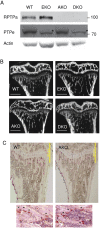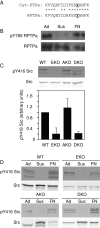Protein tyrosine phosphatases ε and α perform nonredundant roles in osteoclasts
- PMID: 24694598
- PMCID: PMC4038506
- DOI: 10.1091/mbc.E14-03-0788
Protein tyrosine phosphatases ε and α perform nonredundant roles in osteoclasts
Abstract
Female mice lacking protein tyrosine phosphatase ε (PTP ε) are mildly osteopetrotic. Osteoclasts from these mice resorb bone matrix poorly, and the structure, stability, and cellular organization of their podosomal adhesion structures are abnormal. Here we compare the role of PTP ε with that of the closely related PTP α in osteoclasts. We show that bone mass and bone production and resorption, as well as production, structure, function, and podosome organization of osteoclasts, are unchanged in mice lacking PTP α. The varying effects of either PTP on podosome organization in osteoclasts are caused by their distinct N-termini. Osteoclasts express the receptor-type PTP α (RPTPa), which is absent from podosomes, and the nonreceptor form of PTP ε (cyt-PTPe), which is present in these structures. The presence of the unique 12 N-terminal residues of cyt-PTPe is essential for podosome regulation; attaching this sequence to the catalytic domains of PTP α enables them to function in osteoclasts. Serine 2 within this sequence regulates cyt-PTPe activity and its effects on podosomes. We conclude that PTPs α and ε play distinct roles in osteoclasts and that the N-terminus of cyt-PTPe, in particular serine 2, is critical for its function in these cells.
© 2014 Finkelshtein et al. This article is distributed by The American Society for Cell Biology under license from the author(s). Two months after publication it is available to the public under an Attribution–Noncommercial–Share Alike 3.0 Unported Creative Commons License (http://creativecommons.org/licenses/by-nc-sa/3.0).
Figures






Similar articles
-
Adaptor protein GRB2 promotes Src tyrosine kinase activation and podosomal organization by protein-tyrosine phosphatase ϵ in osteoclasts.J Biol Chem. 2014 Dec 26;289(52):36048-58. doi: 10.1074/jbc.M114.603548. Epub 2014 Nov 7. J Biol Chem. 2014. PMID: 25381250 Free PMC article.
-
Protein tyrosine phosphatase epsilon regulates integrin-mediated podosome stability in osteoclasts by activating Src.Mol Biol Cell. 2009 Oct;20(20):4324-34. doi: 10.1091/mbc.e08-11-1158. Epub 2009 Aug 19. Mol Biol Cell. 2009. PMID: 19692574 Free PMC article.
-
Dimerization in vivo and inhibition of the nonreceptor form of protein tyrosine phosphatase epsilon.Mol Cell Biol. 2003 Aug;23(15):5460-71. doi: 10.1128/MCB.23.15.5460-5471.2003. Mol Cell Biol. 2003. PMID: 12861030 Free PMC article.
-
Protein tyrosine phosphatases in osteoclast differentiation, adhesion, and bone resorption.Eur J Cell Biol. 2008 Sep;87(8-9):479-90. doi: 10.1016/j.ejcb.2008.01.006. Epub 2008 Mar 14. Eur J Cell Biol. 2008. PMID: 18342392 Review.
-
The roles of protein tyrosine phosphatases in bone-resorbing osteoclasts.Biochim Biophys Acta Mol Cell Res. 2019 Jan;1866(1):114-123. doi: 10.1016/j.bbamcr.2018.07.005. Epub 2018 Jul 17. Biochim Biophys Acta Mol Cell Res. 2019. PMID: 30026076 Review.
Cited by
-
Receptor Protein Tyrosine Phosphatase α-Mediated Enhancement of Rheumatoid Synovial Fibroblast Signaling and Promotion of Arthritis in Mice.Arthritis Rheumatol. 2016 Feb;68(2):359-69. doi: 10.1002/art.39442. Arthritis Rheumatol. 2016. PMID: 26414708 Free PMC article.
-
Tuning the Protein Phosphorylation by Receptor Type Protein Tyrosine Phosphatase Epsilon (PTPRE) in Normal and Cancer Cells.J Cancer. 2019 Jan 1;10(1):105-111. doi: 10.7150/jca.27633. eCollection 2019. J Cancer. 2019. PMID: 30662530 Free PMC article. Review.
-
Adaptor protein GRB2 promotes Src tyrosine kinase activation and podosomal organization by protein-tyrosine phosphatase ϵ in osteoclasts.J Biol Chem. 2014 Dec 26;289(52):36048-58. doi: 10.1074/jbc.M114.603548. Epub 2014 Nov 7. J Biol Chem. 2014. PMID: 25381250 Free PMC article.
-
Hereditable variants of classical protein tyrosine phosphatase genes: Will they prove innocent or guilty?Front Cell Dev Biol. 2023 Jan 23;10:1051311. doi: 10.3389/fcell.2022.1051311. eCollection 2022. Front Cell Dev Biol. 2023. PMID: 36755664 Free PMC article. Review.
References
-
- Amoui M, Sheng MH, Chen ST, Baylink DJ, Lau KH. A transmembrane osteoclastic protein-tyrosine phosphatase regulates osteoclast activity in part by promoting osteoclast survival through c-Src-dependent activation of NFkappaB and JNK2. Arch Biochem Biophys. 2007;463:47–59. - PubMed
-
- Aoki K, Didomenico E, Sims NA, Mukhopadhyay K, Neff L, Houghton A, Amling M, Levy JB, Horne WC, Baron R. The tyrosine phosphatase SHP-1 is a negative regulator of osteoclastogenesis and osteoclast resorbing activity: increased resorption and osteopenia in me(v)/me(v) mutant mice. Bone. 1999;25:261–267. - PubMed
Publication types
MeSH terms
Substances
LinkOut - more resources
Full Text Sources
Other Literature Sources
Molecular Biology Databases

